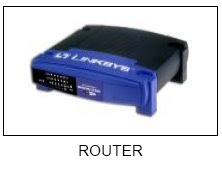Advantages of the Internet
1. Information overload.
2. No librarians for quality control(with some exceptions, like Kids Click! And other sites for children).
3. Need for quality control in the data that student find and use.
4. Search engine that show result base on who pays the most.
5. Not enough training for effective use.
6. Push to upgrade constantly.
INTERNET REQUIREMENTS
1. Network Interface Card ( NIC )

2. Access Account
New subscriber needs to subscribe for an account from the service provider (ISP). There are several listed internet service providers in Malaysia such as JARING, TELEKOM MALAYSIA - TMnet, MAXIS - maxis.net and TIME.COM - time.net.
There are two ways of accessing the internet:
a. Direct access:
User computers are directly connected to the internet through a local network server
b. Dial-up:
Accessing the internet is made by making a call through the telephone line to the ISP
3. Wireless Network Interface Card
Is a network card which connects to a radio-based computer network. It uses an antenna to communicate through microwave. A WNIC can operate in two modes known as infrastructure mode and ad hoc mode. In an infrastructure mode network the WNIC needs an access point while an ad hoc mode network the WNIC does not require an access point.
External modem can be attached to any computer that has an RS-232 port. An internal modem is an expansion board that can be inserted into vacant expansion slot in a computer.


5. Hub / Switch
A hub is a device acting as the cable center of a network that uses to connect segments of LAN and has either 8 or 16 port. Hub broadcasts the data that it receives from one port to all of its port.
A switch can also connect multiple communication lines and it can receive packets from different protocol. Switch is more intelligent than a hub as it will on only deliver the data to the particular port. This actually helps to make the network significantly faster. It filters and forward packers between a LAN segments.

6. Router
A router is attached to two or more networks an forwards Packets form one network to another. It acts as a junction between two or more networks to butter and transfer data packets among them.

7. Wireless Access Point
Wireless access point or AP is a device that connects wireless communication devices together to form a wireless network. It is usually connects to a wired network and can relay data between wireless and wired devices.
